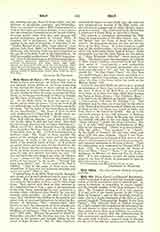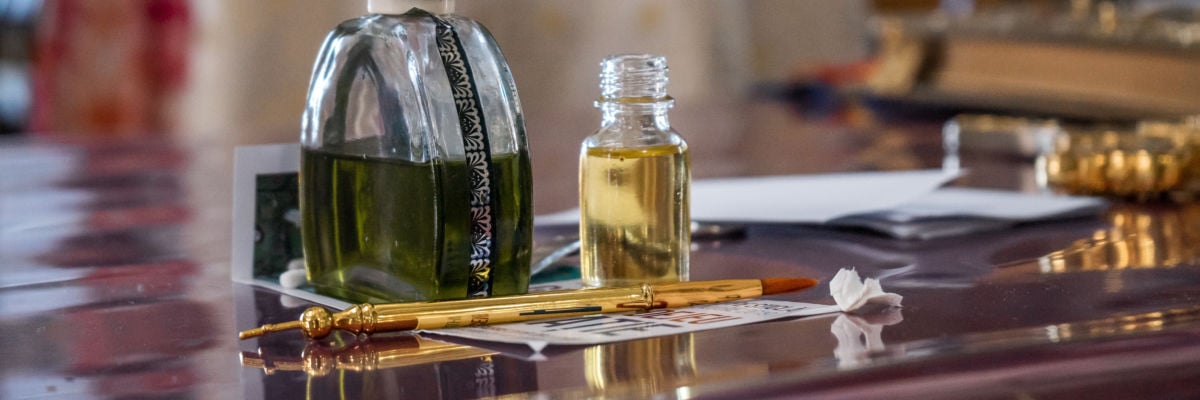

Holy Oils (OLEA SACRA).—Liturgical Benediction.—Oil is a product of great utility the symbolic signification of which harmonizes with its natural uses. It serves to sweeten, to strengthen, to render supple; and the Church employs it for these purposes in its rites. The liturgical blessing of oil is very ancient. It is met with in the fourth century in the “Prayer Book of Serapion“, and in the Apostolic Constitutions, also in a Syriac document of the fifth or sixth century entitled “Testamentum Domini Nostri Jesu Christi”. The aforesaid book of Bishop Serapion (d. c. 362) contains the formula for the blessing of the oil and chrism for those who had just received baptism, which was in those days followed by confirmation in such a manner that the administration of both sacraments constituted a single ceremony. In the same book is found a separate form of blessing for the oil of the sick, for water, and for bread. It is an invocation to Christ to give His creatures power to cure the sick, to purify the soul, to drive away impure spirits, and to wipe out sins. In the Old Testament oil was used for the consecration of priests and kings, also in all great liturgical functions, e.g., sacrifices, legal purifications, and the consecration of altars (Exod., xxx, 23, 33; xxxix, 27, 29; xl, 9, 15; Levit., vi, 15 sq.).
In the primitive Church the oils to be used in the initiation of catechumens were consecrated on Holy Thursday in the Missa Chrismalis. Two different ampullae were used, one containing pure oil, the other oil mixed with balsam. This mixture was made by the pope himself before the Mass, in the sacristy. During the Mass two clerics of lesser rank stood before the altar holding the ampullae. Towards the end of the Canon the faithful offered for benediction small ampullae of oil; these contained oil of the sick which the faithful were allowed to make use of themselves (Tertull., “Ad Scap.”, iv), but the same oil also served for extreme unction. The vessels holding it were placed on the railing surrounding the space reserved for the clergy. The deacons brought some of these vessels to the altar to receive that blessing of the pope which we read today in the Gelasian and Gregorian Sacramentaries. The pope continued the Mass while the deacons returned the ampullae to the place whence they had brought them, and a certain number of bishops and priests repeated over those which had not been brought to the altar the formula pronounced by the pope. The consecration of the large ampullae took place immediately after the Communion of the pope, before the Communion of the clergy and the faithful. The deacons covered the chalice and paten, while the subdeacons carried the ampullae to the archdeacon and one of his assistants. The archdeacon presented to the pope the ampulla of perfumed oil, the pontiff breathed on it three times, made the sign of the cross, and recited a prayer which bears a certain resemblance to the Preface of the Mass. The ampulla of pure oil was next presented to the pope, and was consecrated with less solemnity. The consecration and benediction of the holy oils now take place on Holy Thursday at a very solemn ceremony reserved for the bishop. He blesses the oil which is to serve at the anointing of catechumens previous to baptism, next the oil with which the sick are anointed in the Sacrament of Extreme Unction, finally the chrism, which is a mixture of oil and balsam, and which is used in the administration of the Sacrament of Confirmation.
The Oil of the Sick.—The use of oil in Christian antiquity was not, as has been maintained, a medical prescription adopted by the Church. In Apostolic times St. James directed the priests or ancients of the community to pray for the sick man and to anoint him with oil in the name of Jesus (James, v, 14). And shortly afterwards, probably in the second century, a gold leaf found at Beyrout, in Syria, contains an exorcism “pronounced in the dwelling of him whom I anointed”. This is, after the text of St. James, the earliest evidence of the use of oil accompanied by a formula in the administration of a sacrament [see Theophilus of Antioch (d. 181), “Ad. Autolyc.”, I, xii, in P.G., VI, 10421. The oil of the sick might be blessed not only by priests, but also by laymen of high repute for virtue, and even by women. In the sixth century St. Monegundus on his deathbed blessed oil and salt which were afterwards used for the sick (“Vita S. Monegundi”, ix, in “Acts. SS. Ord. S. Bened.”, I, 204; Gregory of Tours, “Vita Patr.”, xix, 4). A similar instance is met with in the life of St. Radegund (Vita Radeg., I, xxxv). In the West, however, the tendency was early manifested to confine the blessing of the oil of the sick to bishops only; about 730 St. Boniface ordered all priests to have recourse to the bishop (Statut., xxix). In 744 the tendency was not so pronounced in France, but the Council of Chalons (813) imposed on priests the obligation of anointing the sick with oil blessed by the bishop (can. xlviii). In the East the priests retained the right to consecrate the oil. The custom even became established, and has lasted to the present time, of having the oil blessed in the house of the sick person, or in the church, by a priest, or, if possible, by seven priests.
Oil of Catechumens.—During the time of the catechumenate those who were about to become Christians received one or more anointings with holy oil. The oil used on this occasion was that which had received the blessing mentioned in the Apostolic Constitutions (VII, xlii). This anointing of the catechumens is explained by the fact that they were regarded to a certain extent as being possessed by the devil until Christ should enter into them through baptism. The oil of catechumens is also used in the ordination of priests and the coronation of kings and queens.
Oil of Chrism.—This is used in the West immediately after baptism; both in the East and West it was used very early for the Sacrament of Confirmation (see Chrism).
Oil in the Agnus Dei.—The “Ordo Romanus” (c. 730) shows that in Rome, on Holy Thursday, the archdeacon went very early to St. John Lateran, where he mixed wax and oil in a large vase, this mixture being used to make the Agnus Deis (Mabillon, “Mus. Ital.”, II, 31). The same document shows that in the suburban churches wax was used while Pseudo-Alcuin (Divin. Offic., xix) says that both wax and oil were used.
Oil in the Eucharistic Bread.—In the Liturgy of the Nestorians and the Syrian Jacobites, the elements presented at the Eucharistic Consecration have been prepared with oil. Among the Nestorians a special rubric prescribes the use of flour, salt, olive oil, and water (“Officium Renovationis fermenti”; Martene, “De antiquis Eccles. ritib.”, I, iii, 7; Badger, “Nestorians”, II, 162; Lebrun, “Explic. des prieres de la messe”, dissert. xi, 9).
Oil in the Font.—From the second century the custom was established of administering baptism with water specially blessed for this purpose. Nevertheless, the sacrament was valid if ordinary water was used. We are not well informed as to the nature of the consecration of this baptismal water, but it must be said that the most ancient indications and descriptions say nothing of the use of oil in this consecration. The first witness, Pseudo-Dionysius, does not go beyond the first half of the sixth century; he tells us that the bishop pours oil on the water of the fonts in the form of a cross (De hierarch. eccles., IV, x; cf. II, vii). There is no doubt that this rite was introduced at a comparatively late period.
Oil in Church Lamps.—The maintenance of more or less numerous lamps in the churches was a source of expense which the faithful in their generosity hastened to meet by establishing a fund to purchase oil. The Council of Braga (572) decided that a third of the offerings made to the Church should be used for purchasing oil for the light. The quantity of oil thus consumed was greater when the lamp burned before a famous tomb or shrine, in which case it was daily distributed to pilgrims, who venerated it as a relic (Kraus, “Real-Encykl.”, II, 522). (See Lights.)
H. LECLERCQ


